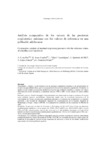Mostrar o rexistro simple do ítem
Análisis comparativo de los valores de las presiones respiratorias máximas con los valores de referencia en una población adulta sana
| dc.contributor.author | Lista-Paz, Ana | |
| dc.contributor.author | Souto-Camba, Sonia | |
| dc.contributor.author | Vilaró, Jordi | |
| dc.contributor.author | Quintela-del-Río, Alejandro | |
| dc.contributor.author | López García, Asenet | |
| dc.contributor.author | González Doniz, Luz | |
| dc.date.accessioned | 2021-08-17T10:13:39Z | |
| dc.date.available | 2021-08-17T10:13:39Z | |
| dc.date.issued | 2019-05-09 | |
| dc.identifier.citation | Lista-Paz A, Souto-Camba S, Vilaró Casamitjana J, Quintela-del-Río A, López García A, González Doniz L. Análisis comparativo de los valores de las presiones respiratorias máximas con los valores de referencia en una población adulta sana. Fisioterapia. 2019:41(4):200-206 | es_ES |
| dc.identifier.issn | 0211-5638 | |
| dc.identifier.uri | http://hdl.handle.net/2183/28258 | |
| dc.description.abstract | [Resumen] Antecedentes y objetivo. La determinación de las presiones respiratorias máximas es un procedimiento no invasivo de gran utilidad clínica para la evaluación de la fuerza de los músculos respiratorios. El objetivo es analizar en qué medida las ecuaciones predictivas existentes para población española, se ajustan a los valores observados de presión inspiratoria y espiratoria máximas (PEM y PIM) en una muestra de sujetos adultos sanos. Material y métodos. Estudio descriptivo observacional de corte transversal en el que se reclutaron 63 sujetos sanos mediante muestreo probabilístico aleatorizado simple entre la comunidad universitaria de la Universidade da Coruña. Las presiones respiratorias máximas se efectuaron con un transductor de presiones conectado a una boquilla de submarinista, siguiendo las recomendaciones de la Sociedad Española de Neumología y Cirugía Torácica (SEPAR). Se compararon los resultados con las ecuaciones de Morales de 1997. Resultados. Se presentan los datos de 24 mujeres y 39 hombres (45,94 ± 16,71 años). Existe una diferencia estadísticamente significativa en las mujeres de -19,08 ± 23,57 cmH2O y de -28,13 ± 29,93 cmH2O para la PIM y la PEM, respectivamente, entre el valor observado y el valor predicho. Asimismo, en el caso de los hombres se observó una diferencia estadísticamente significativa de -25,18 ± 24,31 cmH2O para la PIM y de -39,53 ± 44,38 cmH2O para la PEM. Conclusiones. Las ecuaciones predictivas disponibles para las presiones respiratorias máximas sobreestiman considerablemente los valores alcanzados de la PIM y la PEM. Los resultados del presente estudio ponen de manifiesto la necesidad de realizar nuevas ecuaciones de referencia a través de un estudio multicéntrico representativo de toda la población española. | es_ES |
| dc.description.abstract | [Abstract] Background and aim. The determination of maximal respiratory pressures is a non-invasive process of high clinical value for assessing respiratory muscle strength. The aim is to analyse to what extent the existing predictive equations for the Spanish population are adjusted to the maximal inspiratory and expiratory pressures (MIP and MEP) values observed in a sample of healthy adult subjects. Material and methods. A cross-sectional study was conducted on a sample of 63 healthy subjects recruited from the A Coruña University community using a simple random probabilistic method. Maximal respiratory pressures were performed using a pressure transducer connected to a scuba mouthpiece according to the standards of Spanish Society of Pulmonology and Thoracic Surgery (SEPAR). The results were compared with predictive equations proposed by Morales in 1997. Results. The study included the results from 24 females and 39 males (45.94 ± 16.71 years). Females showed a statically significant difference between the observed and predictive values, with -19.08 ± 23.57 cmH2O and -28.13 ± 29.93 cmH2O for MIP and MEP. A statistically significant difference was also observed for males with -25.18 ± 24.31 cmH2O for MIP and -39.53 ± 44.38 cmH2O for MEP. Conclusions. Predictive equations to calculate the theoretical values of maximal respiratory pressures in a healthy Spanish adult population overestimate considerably the real values of MIP and MEP. The results of this study highlight the need to create new reference equations by conducting a multicentre study representative of the entire Spanish population. | es_ES |
| dc.language.iso | spa | es_ES |
| dc.publisher | Elsevier | es_ES |
| dc.relation.uri | https://doi.org/10.1016/j.ft.2019.03.007 | es_ES |
| dc.rights | Creative Commons Attribution-NonCommercial-NoDerivs 4.0 International Licence (CC-BY-NC-ND 4.0) | es_ES |
| dc.rights.uri | http://creativecommons.org/licenses/by-nc-nd/4.0/ | * |
| dc.subject | Presiones respiratorias máximas | es_ES |
| dc.subject | Test de función respiratoria | es_ES |
| dc.subject | Músculos respiratorios | es_ES |
| dc.subject | Valores de referencia | es_ES |
| dc.subject | Maximal respiratory pressures | es_ES |
| dc.subject | Respiratory function tests | es_ES |
| dc.subject | Respiratory muscles | es_ES |
| dc.subject | Reference values | es_ES |
| dc.title | Análisis comparativo de los valores de las presiones respiratorias máximas con los valores de referencia en una población adulta sana | es_ES |
| dc.title.alternative | Comparative analysis of maximal respiratory pressures with the reference values of a healthy adult population | es_ES |
| dc.type | journal article | es_ES |
| dc.rights.accessRights | open access | es_ES |
| UDC.journalTitle | Fisioterapia | es_ES |
| UDC.volume | 41 | es_ES |
| UDC.issue | 4 | es_ES |
| UDC.startPage | 200 | es_ES |
| UDC.endPage | 206 | es_ES |
| UDC.coleccion | Investigación | es_ES |
| UDC.departamento | Psicoloxía | es_ES |
| UDC.grupoInv | Intervención Psicosocial e Rehabilitación Funcional | es_ES |
Ficheiros no ítem
Este ítem aparece na(s) seguinte(s) colección(s)
-
Investigación (FFISIO) [503]






